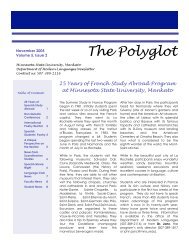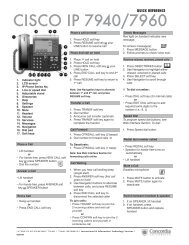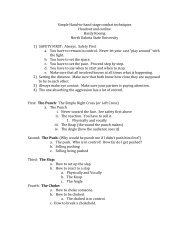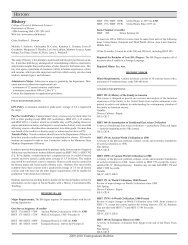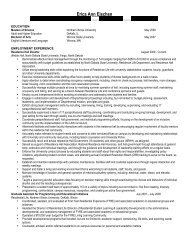Observers' Perceptions of Self-handicappers' and Sandbaggers ...
Observers' Perceptions of Self-handicappers' and Sandbaggers ...
Observers' Perceptions of Self-handicappers' and Sandbaggers ...
You also want an ePaper? Increase the reach of your titles
YUMPU automatically turns print PDFs into web optimized ePapers that Google loves.
Observers’ <strong>Perceptions</strong> <strong>of</strong><br />
<strong>Self</strong>-h<strong>and</strong>icappers’ <strong>and</strong><br />
S<strong>and</strong>baggers’ Motives<br />
Jeannie M. Korngable<br />
Daniel Sachau (Faculty Mentor)<br />
Minnesota State University, Mankato
Overview<br />
� Purpose <strong>of</strong> the study:<br />
To examine how observer’s rate the<br />
competence <strong>and</strong> character <strong>of</strong> people<br />
who self-h<strong>and</strong>icap <strong>and</strong> s<strong>and</strong>bag.
<strong>Self</strong>-h<strong>and</strong>icapping<br />
� <strong>Self</strong>-presentation strategy in which a person<br />
creates obstacles to his or her own<br />
performance either to provide an excuse for<br />
failure or to enhance success (Franzoi, 2003).<br />
� Drinking the night before a test<br />
� Using drugs<br />
� Intentionally not preparing<br />
� Withdrawing effort during a task
Benefits <strong>of</strong> <strong>Self</strong>-h<strong>and</strong>icapping<br />
� Creates doubts about inability if one fails<br />
� Enhances perceived ability if one succeeds
S<strong>and</strong>bagging<br />
� <strong>Self</strong>-presentation strategy involving the false<br />
claim or feigned demonstration <strong>of</strong> inability<br />
used to create artificially low expectations for<br />
the s<strong>and</strong>baggers’ performance (Gibson & Sachau,<br />
2000).<br />
� Pool shark<br />
� Ringer
Benefits <strong>of</strong> S<strong>and</strong>bagging<br />
� Reduces performance pressure<br />
� Performance contrast effect
Costs <strong>of</strong> S<strong>and</strong>bagging<br />
� Observers may become aware that they<br />
have been conned.<br />
� Phony, manipulative, <strong>and</strong> dishonest<br />
� Observers may “see” poor performance<br />
� Hypothesis confirmation processes
Compare <strong>and</strong> Contrast<br />
� <strong>Self</strong>-h<strong>and</strong>icapping<br />
� Negative statement<br />
prior to performance<br />
� True Claim<br />
� External excuse for<br />
poor performance<br />
� “I have been<br />
drinking”<br />
� “I am ill”<br />
� “I have not<br />
prepared”<br />
� S<strong>and</strong>bagging<br />
� Negative statement<br />
prior to performance<br />
� False Claim<br />
� Internal excuse for<br />
poor performance<br />
� “I am not skilled”<br />
� “I am not capable”<br />
� “I am not smart<br />
enough”
Method<br />
� Participants<br />
� 97 Introductory psychology students at MNSU<br />
� Participants read a short scenario where Justin:<br />
� Claimed or Did Not Claim a sickness<br />
� that he either Had or Did Not Have,<br />
� <strong>and</strong> then he Failed or Succeeded on a test.<br />
� 2 (claim) x 2 (sickness) x 2 (success) design
Design<br />
Fail<br />
Succeed<br />
Not Claim Injury Claim Injury<br />
Not Have<br />
Injury<br />
Have<br />
Injury<br />
Not have<br />
Injury<br />
S<strong>and</strong>bagging<br />
S<strong>and</strong>bagging<br />
Have<br />
Injury<br />
<strong>Self</strong>-<br />
H<strong>and</strong>icapping<br />
<strong>Self</strong>-<br />
H<strong>and</strong>icapping
(+)<br />
Hypotheses: Competence<br />
Fail<br />
Succeed<br />
Not Claim Injury Claim Injury<br />
Not Have<br />
Injury<br />
(+)<br />
Have<br />
Injury<br />
(+)<br />
(+)<br />
(+)<br />
(+) (+)<br />
Not have<br />
Injury<br />
(SB)<br />
(+)<br />
Have<br />
Injury<br />
(SH)<br />
(+)<br />
(+)<br />
(+)
Hypotheses: Honesty<br />
Fail<br />
Succeed<br />
Not Claim Injury Claim Injury<br />
Not Have<br />
Injury<br />
Have<br />
Injury<br />
Not have<br />
Injury<br />
(SB)<br />
(-)<br />
(-)<br />
Have<br />
Injury<br />
(SH)
Hypotheses: Insecurity<br />
Fail<br />
Succeed<br />
Not Claim Injury Claim Injury<br />
Not Have<br />
Injury<br />
Have<br />
Injury<br />
(+)<br />
Not have<br />
Injury<br />
(SB)<br />
(+) (+)<br />
(+) (+)<br />
Have<br />
Injury<br />
(SH)<br />
(+)<br />
(+)<br />
(+)
Hypotheses: Likeability<br />
Fail<br />
Succeed<br />
Not Claim Injury Claim Injury<br />
Not Have<br />
Injury<br />
Have<br />
Injury<br />
(-)<br />
Not have<br />
Injury<br />
(SB)<br />
(-) (-)<br />
(-) (-)<br />
Have<br />
Injury<br />
(SH)<br />
(-)<br />
(-)<br />
(-)
Dependent Measures<br />
Participants rated Justin’s:<br />
1) Competence: smart, competent, intelligent<br />
2) Honesty: trustworthy, honest, manipulative (rev)<br />
3) Insecurity<br />
4) Likable
(+)<br />
Results: Competence<br />
Fail<br />
Succeed<br />
P < .001<br />
Not Claim Injury Claim Injury<br />
Not Have<br />
Injury<br />
6.5<br />
(+)<br />
9.6<br />
(+) (+)<br />
Have<br />
Injury<br />
(+)<br />
7.5<br />
(+)<br />
(+)<br />
10.7<br />
Not have<br />
Injury<br />
(SB)<br />
6.8<br />
(+)<br />
9.7<br />
Have<br />
Injury<br />
(SH)<br />
(+)<br />
7.8<br />
(+)<br />
(+)<br />
10.1<br />
P < .009
Results: Honesty<br />
Fail<br />
Succeed<br />
Not Claim Injury Claim Injury<br />
Not Have<br />
Injury<br />
9.0<br />
8.8<br />
Have<br />
Injury<br />
8.4<br />
9.2<br />
Not have<br />
Injury<br />
(SB)<br />
6.2<br />
(-)<br />
(-)<br />
6.9<br />
P < .04<br />
P < .001<br />
Have<br />
Injury<br />
(SH)<br />
7.7<br />
(+)<br />
8.5
Results: Insecurity<br />
Fail<br />
Succeed<br />
Not Have<br />
Injury<br />
2.4<br />
1.9<br />
Have<br />
Injury<br />
2.6<br />
2.3<br />
Not have<br />
Injury<br />
(SB)<br />
3.2<br />
3.0<br />
P < .004<br />
Not Claim Injury Claim Injury<br />
Have<br />
Injury<br />
(SH)<br />
2.5<br />
2.7<br />
Penalty P < .06
Results: Likeability<br />
Fail<br />
Succeed<br />
Not Claim Injury Claim Injury<br />
Not Have<br />
Injury<br />
2.9<br />
2.8<br />
Have<br />
Injury<br />
2.8<br />
2.8<br />
Not have<br />
Injury<br />
(SB)<br />
2.4<br />
(-) (-)<br />
(-) (-)<br />
2.8<br />
Have<br />
Injury<br />
(SH)<br />
2.5<br />
(-)<br />
(-)<br />
2.8<br />
Sachau & Gibson
Discussion<br />
� People who perform with sickness are<br />
perceived as more competent.<br />
� S<strong>and</strong>bagging has penalty<br />
� seen as less honest<br />
� seen as less secure<br />
� <strong>Self</strong>-h<strong>and</strong>icapping did not have penalties<br />
� No effect for likeability
Future Research<br />
� More detailed scenarios to increase realism<br />
� Incorporate self-esteem measures <strong>of</strong> P’s<br />
� Incorporate personality measures <strong>of</strong> P’s<br />
� Larger & broader subject pool
References<br />
Carter, R. F. (1959). B<strong>and</strong>wagon <strong>and</strong> s<strong>and</strong>bagging effects: Some measures <strong>of</strong> dissonance<br />
reduction. The Public Opinion Quarterly, 23, 279-287. Retrieved October 31, 2006, from the JSTORE<br />
database.<br />
Darley, J. M., & Fazio, R. H. (1980). Expectancy confirmation processes arising in the social<br />
interaction sequence. American Psychologist, 35, 867-881.<br />
Franzoi, S. L. (2003). Social Psychology (3rd ed.). New York: McGraw-Hill.<br />
Gibson, B., & Sachau, D. (2000). S<strong>and</strong>bagging as a self-presentational strategy: Claiming to be<br />
less than you are. Personality <strong>and</strong> Social Psychology Bulletin, 56-70.<br />
Gibson, B., & Sachau, D. (DATE). A typology <strong>of</strong> performance related self-presentations: What<br />
qualities <strong>of</strong> self-presentational statements lead to positive audience evaluations? (How should I site this<br />
article?)<br />
Gibson, B., Sachau, D., Doll, B. (DATE). S<strong>and</strong>bagging in competition: Avoiding the pressure <strong>of</strong><br />
being the favorite. (How should I site this article?)<br />
Jones, E. E., & Berglas, S. (1978). Control <strong>of</strong> attribution about the self through self-h<strong>and</strong>icapping<br />
strategies: The appeal <strong>of</strong> alcohol <strong>and</strong> the role <strong>of</strong> underachievement. Personality <strong>and</strong> Social Psychology<br />
Bulletin, 4, 200-206.<br />
Lewis, M.A., & Clayton Neighbors. (2005). <strong>Self</strong>-Determination <strong>and</strong> the use <strong>of</strong> self-presentation<br />
strategies. The Journal <strong>of</strong> Social Psychology, 145, 469-489. Retrieved October 31, 2006, from the<br />
ProQuest Psychology Journals.<br />
Rhodewalt, F., & Agustdottir, S. (1986). Effects <strong>of</strong> self-presentation on the phenomenal self.<br />
Journal <strong>of</strong> Personality <strong>and</strong> Social Psychology, 50, 47-55.<br />
Snyder, M., & Swann, W. B. (1978). Behavioral confirmation in social interaction: From social<br />
perception to social reality. Journal <strong>of</strong> Personality <strong>and</strong> Social Psychology, 36, 1202-1212.<br />
Snyder, M., Tanke, E. D., & Berscheild, E. (1977). Social perception <strong>and</strong> interpersonal behavior:<br />
On the self-fulfilling nature <strong>of</strong> social stereotypes. Journal <strong>of</strong> Personality <strong>and</strong> Social Psychology, 35, 656-<br />
666.<br />
Want, J., & Kleitman, S. (2005). Imposter phenomenon <strong>and</strong> self-h<strong>and</strong>icapping: Links with<br />
parenting styles <strong>and</strong> self-confidence. Personality <strong>and</strong> Individual Differences. Retrieved October 31, 2006,<br />
from the ScienceDirect database.
S<strong>and</strong>bagging Scenario 1<br />
Justin is just beginning his first year as an<br />
undergraduate at a local state college. Two weeks<br />
have past since the first day <strong>of</strong> biology class, <strong>and</strong><br />
Justin has to take his first test. On the day <strong>of</strong> the test,<br />
Justin takes a seat in the classroom <strong>and</strong> starts talking<br />
to some <strong>of</strong> the students around him. Although Justin<br />
is healthy, he states, “I do not think I will do well<br />
on the test because I have had the flu for the past<br />
two days.” The students nod around him <strong>and</strong> the<br />
pr<strong>of</strong>essor proceeds to pass out the test.<br />
The next class, as the pr<strong>of</strong>essor h<strong>and</strong>s back the test,<br />
Justin notices he had received a D. As the rest<br />
students review their test results, Justin turns to the<br />
students around him says, “Uh, I can’t believe I got a<br />
D!”




